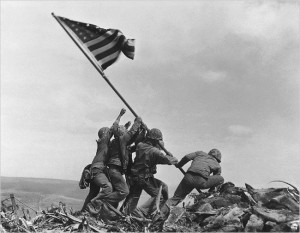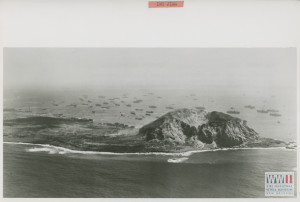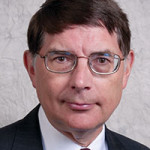FLAGS, MEMORIES, AND IWO JIMA

US Marines of the 28th Regiment, 5th Division, raise the American flag atop Mount Suribachi, Iwo Jima, on February 23, 1945. Strategically located only 660 miles from Tokyo, the Pacific island became the site of one of the bloodiest, most famous battles of World War II against Japan. (AP Photo/Joe Rosenthal)
The Marine Corps has officially spoken and affirmed the work of two history buffs that Pharmacist Mate 2nd Class John Bradley is not in Joe Rosenthal’s immortal photograph of the flag raising on Iwo Jima and that the sixth man in the image is Private First Class Harold Schultz. For many this raises an unanswered question: How could Bradley have abided his misidentification as one of the famous flag raisers while Schultz maintained silence about his actual participation? While a firm answer is beyond our reach, we can try to understand that context will steer us away from unwarranted judgments about either man.
There are two critical factors here well outside the understanding of most Americans. The first is that Joe Rosenthal’s image captured the second flag raising on Mount Suribachi. As the participants understood events, the first flag raising was the great event. They merely participated in a much lesser moment to raise a second and larger flag atop Mount Suribachi. None of them had the slightest inkling that they were in an immortal photograph.
The second critical factor is that both men, by the end of their service on Iwo Jima, were in a state of mental fog beyond comprehension to those who have not endured parallel experiences. The flag raisings came on the fifth day of the fighting; the battle would go on for another 31 days. During that time, extreme physical and emotional stress pummeled participants in an endless series of kill-or-be-killed moments while they witnessed countless comrades killed or maimed. They endured on mere shards of sleep. This combination shredded the brain’s ability to retain and to organize memories—not to mention the brain’s conscious or unconscious work to suppress terrifying or profoundly disturbing memories. Bradley had participated in the first flag raising. It is entirely plausible that even though he had no specific memory of being in the famous photograph, he was easily swayed by others to believe he was. And make no mistake: Bradley was a genuine hero as evidenced by the award of the Navy Cross, a decoration just below the Medal of Honor.

Aerial view of Mount Suribachi on Iwo Jima showing US landings taking place on February 24, 1945. US Navy Official photograph, Gift of Charles Ives, from the collection of The National WWII Museum.
For Harold Schultz, one quite plausible explanation for his silence is that he had no memory, or an uncertain memory, of participating in the second flag raising. And for Schultz there may have been yet another factor–he survived while a great many others perished. His innate sense of honor precluded him from advancing himself as a participant in an event he did not see as actually heroic and thus to elevate his recognition over that of many dead comrades.
Ultimately, as the Marine Corps Commandant correctly affirmed, “It’s not about the individuals and never has been.” It is impossible to distinguish the faces of any of the flag raisers in the image. The power of the image is and always will be the stunning symbolism of collective effort and valor.
 Richard Frank is an internationally renowned expert on the Pacific war. After graduating from the University of Missouri, he was commissioned in the US Army, in which he served for nearly four years, including a tour of duty in the Republic of Vietnam as an aerorifle platoon leader with the 101st Airborne Division. His works include Guadalcanal: The Definitive Account of the Landmark Campaign, which won the United States Marine Corps’ General Wallace M. Greene Award; Downfall: The end of the Imperial Japanese Empire, which won the 2000 Harry S. Truman Book Award; and MacArthur. He has appeared numerous times on or consulted for programs on television and radio, and was also a historical consultant and appeared as a key interviewee in the HBO miniseries The Pacific. He is working on a narrative history trilogy about the Asia–Pacific war. Frank also sits on the Museum’s Presidential Counselors advisory board.
Richard Frank is an internationally renowned expert on the Pacific war. After graduating from the University of Missouri, he was commissioned in the US Army, in which he served for nearly four years, including a tour of duty in the Republic of Vietnam as an aerorifle platoon leader with the 101st Airborne Division. His works include Guadalcanal: The Definitive Account of the Landmark Campaign, which won the United States Marine Corps’ General Wallace M. Greene Award; Downfall: The end of the Imperial Japanese Empire, which won the 2000 Harry S. Truman Book Award; and MacArthur. He has appeared numerous times on or consulted for programs on television and radio, and was also a historical consultant and appeared as a key interviewee in the HBO miniseries The Pacific. He is working on a narrative history trilogy about the Asia–Pacific war. Frank also sits on the Museum’s Presidential Counselors advisory board.
Hear him speak at The 2016 International Conference on World War II, titled 1946: Year Zero—Triumph and Tragedy, November 17-19, 2016, in New Orleans.
- Posted :
- Post Category :
- Tags :
- Follow responses to this entry through the RSS 2.0 feed. You can skip to the end and leave a response. Pinging is currently not allowed.




Leave a Reply